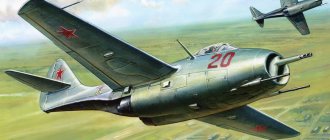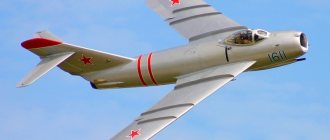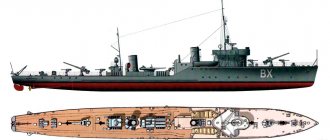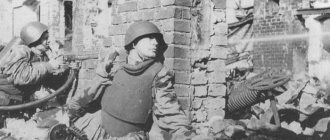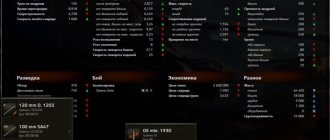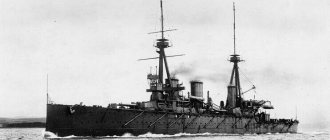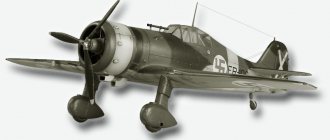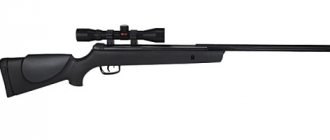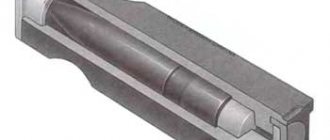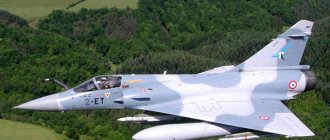The MiG-9 is a Soviet jet fighter developed immediately after the end of the war. It became the first jet fighter made in the USSR. The MiG-9 fighter was mass-produced from 1946 to 1948, during which time more than six hundred combat vehicles were produced.
Aviation history scholars often refer to the MiG-9 and other Soviet combat vehicles (Yak-15 and Yak-17) created during this period as a “transitional type of fighter.” These aircraft were equipped with a jet power plant, but at the same time they had an airframe similar to piston engines.
The MiG-9 fighters were not in service with the Russian Air Force for long: they were taken out of service in the early 50s. In 1950-1951, almost four hundred fighters were transferred to the Chinese Air Force. The Chinese used them mainly as training aircraft: pilots learned to operate jet aircraft on them.
The MiG-9 cannot be called a very successful machine: from the moment testing began, it was plagued by disasters, and the designers continually had to correct defects that appeared during operation. However, we should not forget that the MiG-9 was the first jet fighter; it was created and transferred to the troops in an extremely short time. At the time work began on the creation of this machine, the USSR did not even have an engine that could develop the thrust necessary for jet flight.
The “problematic” MiG-9 was soon replaced by the MiG-15, which both our and foreign experts call one of the best fighters of this period. The designers were able to achieve such success only thanks to the experience gained during the creation of the MiG-9.
The appearance of a large number of jet fighters in the Soviet Union caused surprise in the West. Many there did not believe that a country devastated by war would be able to quickly establish mass production of the latest aircraft technology at that time. The appearance of the MiG-9 and other Soviet jet aircraft had serious political significance. Although, of course, in the West they had no idea about the difficulties and problems that Soviet aviation designers and pilots had to face, as well as what it cost the destroyed country to create new types of weapons.
The history of the creation of the first jet aircraft of the USSR
Already at the end of World War II, it became clear that the future of aviation belonged to jet aircraft. In the Soviet Union, work began in this direction; it went much faster after becoming familiar with captured German developments. At the end of the war, the USSR was able to acquire not only intact German aircraft and jet engines, but also seize the German factories where they were produced.
The task to create a jet fighter was simultaneously received by four leading aviation design bureaus of the country: Mikoyan, Lavochkin, Yakovlev and Sukhoi. The main problem was that at that time the USSR did not have its own jet aircraft engine; it had yet to be created.
Meanwhile, time was running out: potential opponents - the USA, England and Germany - already had established serial production of jet aircraft and were actively exploiting this technology.
The first Soviet jet fighters used captured German BMW-003A and YuMO-004 engines.
The Mikoyan Design Bureau worked on the creation of two fighters, which at the project stage were designated I-260 and I-300. It was planned to use the BMW-003A engine on both cars. Work on the aircraft began in February 1945.
The I-260 copied the German Me.262 fighter; two jet engines were located under the wings of the aircraft. The I-300 had a layout with a power plant inside the fuselage.
Purges in the wind tunnel showed that the layout with engines inside the fuselage is more advantageous. Therefore, it was decided to abandon further work on the I-260 prototype and complete the I-300, which later became the first production Soviet jet fighter under the designation MiG-9.
Three experimental vehicles were built for testing: F-1, F-2 and F-3. The F-1 aircraft was ready by December 1945, but the development of the aircraft took until March of the following year, and only then did testing begin. On April 24, 1946, the fighter took off for the first time; the first flight went well.
Already the initial stage of testing clearly showed the enormous superiority of jet aircraft over piston aircraft: the MiG-9 was able to accelerate to a speed of 920 km/h, reach a ceiling of 13 km and gain an altitude of 5 thousand meters in 4.5 minutes. It should be said that initially they planned to arm the aircraft with a 57-mm N-57 automatic cannon, installing it in the partition between the air intakes and two 37-mm NS-23 cannons located in the lower part of the fuselage. However, later they decided to abandon the 57-mm cannon, considering its power excessive.
On July 11, 1946, a tragedy occurred: during the flight, a fragment that came off the wing damaged the stabilizer, causing the aircraft to lose control and crash into the ground. The pilot died.
The second experimental F-2 aircraft was demonstrated to the public during the air parade in Tushino. In August, the Kuibyshev plant began production of a small production batch of ten aircraft. It was planned that they would take part in the parade on Red Square in October 1946.
In March 1947, serial production of the fighter began. However, after the production of 49 aircraft it was suspended. The car had to be urgently rebuilt. Within two months, the fuel system on the MiG-9 was seriously modernized, the design of the tail fairing was changed, the keel area was increased, and a number of other improvements were also made. After this, mass production was resumed.
In June 1947, state tests of four fighters, two prototypes (F-2 and F-3) and two production aircraft, were completed. In general, the MiG-9 received positive reviews: in terms of speed characteristics, rate of climb and flight altitude, it was significantly superior to all piston aircraft in service with the Soviet army. The firepower of the vehicle was also unprecedented.
There were also problems: when firing cannons at an altitude of more than 7 thousand meters, the engine stalled. They tried to fight this shortcoming, but they could not completely eliminate it.
If we compare the characteristics of the MiG-9 with the Yak-15 jet fighter, which was developed at the same time, then the Mikoyan aircraft was inferior to the Yakovlev Design Bureau aircraft in maneuverability, but was faster in horizontal flight and during a dive.
The new car was greeted by the troops without much enthusiasm. Pilots were often simply afraid to fly an airplane that did not have a propeller. In addition to the pilots, the technical staff also had to be retrained, and this had to be done as quickly as possible. Haste often led to accidents that had nothing to do with the technical features of the aircraft.
Japanese sample
During the Second World War, almost all warring countries sought to produce their first aircraft with a jet engine. Japanese aircraft engineers distinguished themselves by being the first to use a liquid-propellant jet engine in mass production. It was used in the Japanese manned projectile aircraft used to fly kamikazes. From the end of 1944 to the end of World War II, more than 800 such aircraft entered service with the Japanese army.
Description of the design of the MiG-9 fighter
The MiG-9 is an all-metal single-seat fighter aircraft powered by two turbojet engines. It is made according to the classic design with a mid-wing and a three-wheel retractable landing gear.
The aircraft has a semi-monocoque fuselage with a smooth working skin. In its nose there is an air intake, which is divided into two tunnels, each of which supplies air to one of the engines. The channels have an elliptical cross-section; they run along the side parts of the fuselage, bypassing the cockpit on both sides.
The wing of an airplane is trapezoidal in shape with flaps and ailerons.
The tail of the MiG-9 is all-metal with a high-mounted stabilizer.
The pilot's cabin is located in the front part of the fuselage, it is closed by a streamlined canopy consisting of two parts. The front part, the visor, is fixed, and the rear part moves back along three guides. On later modifications of the vehicle, the visor is made of armored glass. In addition, to protect the pilot, the vehicle is equipped with front and rear armor plates, their thickness is 12 mm.
The MiG-9 has a three-post retractable landing gear with a front wheel. The landing gear release system is pneumatic.
The fighter was equipped with a power plant consisting of two RD-20 turbojet engines, which were nothing more than a copy of the German captured BMW-003 engines. Each of them could develop a thrust of 800 kgf. The engines of the first series (A-1) had a service life of only 10 hours, the service life of the A-2 series was increased to 50 hours, and the RD-20B engines could operate for 75 hours. The MiG-9 power plant was launched using Riedel starting motors.
The engines were installed in a modified part of the fuselage, the nozzles were adjustable, they could be set in four positions: “start”, “take-off”, “flight” or “high-speed flight”. The control of the cone of the nozzle apparatus was electrically remote.
To protect the body from hot gases, a special thermal screen was installed on the underside of the tail section, which was a corrugated sheet of heat-resistant steel.
The fuel was placed in ten tanks located in the wings and fuselage. Their total volume was 1595 liters. The fuel tanks were connected to each other to ensure uniform use of fuel, which made it possible to maintain the aircraft's alignment during flight.
The MiG-9 was equipped with an RSI-6 radio station, an RPKO-10M radio semi-compass, and a KP-14 oxygen apparatus. The aircraft received power from a captured LR-2000 generator, which was later replaced by the domestic GSK-1300.
The fighter's armament consisted of one 37-mm N-37 cannon with forty rounds of ammunition and two 23-mm NS-23 cannons with 40 rounds of ammunition. Initially, they planned to equip the aircraft with a more powerful 57-mm N-57 cannon, but this idea was later abandoned.
One of the main problems of the fighter was the entry of powder gases into the engines, since the N-37 cannon was installed on a partition between two air intakes. In later modifications of the aircraft, gas exhaust pipes began to be installed on the N-37. Vehicles produced earlier were already equipped with them in combat units.
The first MiG-9s had a collimator sight, which was later replaced by an automatic rifle sight.
The main innovations implemented on this machine.
I would especially like to note some of the differences of this jet fighter, which were used in our aircraft industry for the first time. The most significant of them are the following things.
- use of starting accelerators;
- braking landing parachute;
- ejection seat with increased travel;
- hydraulic boosters in the aircraft control system;
- possibility of installing an on-board radar;
- aerodynamic brake flaps;
- fighter bomb armament.
Let's look at some of these innovations in more detail.
Characteristics of the MiG-9
Below are the characteristics of the MiG-9.
| Wingspan, m | 10 |
| Length, m | 9.75 |
| Height, m | 3.225 |
| Wing area, sq. m | 18.20 |
| Max. take-off weight, kg | 4998 |
| Engine | 2 RD RD-20 |
| Thrust, kgf | 2 x 800 |
| Max. speed, km,/h | 910 |
| Practical range, km | 800 |
| Rate of climb, m/s | 806 |
| Practical ceiling, m | 12800 |
| Armament | 37 mm N-37 cannon, 2 x 23 mm NS-23 cannons |
Launch boosters and landing parachute.
As for the launch boosters, they were used to reduce the takeoff run length. Their use gave quite significant advantages to the aircraft on takeoff. Without them, the run length was about 910 meters. With accelerators, it reached only 547 meters. In conditions of using an aircraft from airfields where there were short runways
it was impossible to do without such powder accelerators.
For reference. U-5 accelerator
.
Used to shorten the takeoff run of an aircraft. It consisted of a body, a powder block NM-4Sh
and an igniter with three electric igniters. During operation, it developed thrust from 900 to 1200 kg. They worked from 8 to 14 seconds. The starting weight was 130 kg. Length - 1.2 meters. Diameter - 0.32 meters. The operating time depended on the outside temperature.
On Su-9 (first)
two accelerators of the
U-5
, which were attached to the rear on the sides of the fuselage with special locks.
Drawing of the U-5 accelerator
After the work was completed, the locks opened and dumped the spent accelerator on the ground. As for the landing parachute, it was used to reduce the length of the landing run. It has increased due to a significant increase in the landing speed of jet aircraft. Using this parachute, it was possible to reduce the mileage by 30% (from 960 to 660 meters).
conclusions
What can we say as a result? In principle, the plane turned out to be quite good. It was full of various innovations being introduced at the same time. And this is its undoubted advantage. Yes, we borrowed some of them from the Germans and, after the necessary modifications, used them ourselves. In addition, there are many different opinions that the Su-9 (the first)
was completely copied from the German
Me.
262 , although this is not true.
Externally, the aircraft are similar, but have significant design differences. But one way or another it doesn’t matter now. The important thing is that the Soviet aircraft building school received much-needed experience and certain technologies. And in the shortest possible time they were able to catch up with the gap that had emerged during the war. Some three years after its completion, we were already able to create the best jet fighter of the early 50s - the MiG-15
.
Yes, the Su-9 (the first)
did not go into production for the reasons described in the previous article, but nevertheless it left a certain mark on the development of the aviation industry. Some innovations developed on it were used in subsequent projects.
Source - https://zen.yandex.ru/media/review_aviation/su9-pervyi-chto-iz-sebia-predstavlial-pervyi-reaktivnyi-istrebitel-okb-suhogo-5e6f6cc84f80686f3cb70ca8
Museum exhibit
The museum's Ca.20 may not be as crisp, clean, or beautiful as the day it rolled out of the workshop, but those scuffs and holes are part of its beauty.
Unlike most aircraft in museum collections, it is shown almost entirely in its original condition. The Ca.20 wears a finish that has been in use for so long that the tattered fabric shows all the scars and stains of nearly a century of life.
HOTOL
In Britain, attempts to create an aerospace aircraft have been made since the 80s. The now closed HOTOL (Horizontal Take-Off and Landing) project provided for the creation of a videoconferencing system with horizontal take-off and landing. When flying in the lower layers of the atmosphere, the engine of such an aircraft would use outside atmospheric oxygen as an oxidizer, and when rising higher, it would use liquid oxygen from its tanks. The fuel was liquid hydrogen, which was also involved in the direct pre-cooling of the air entering the engine.
Interestingly, one of the project options - HOTOL-2 - provided for the possibility of launching from a carrier aircraft. They were supposed to be the An-325, an eight-engine version of the An-225 we know. But the project turned out to be ineffective compared to traditional rockets. At the same time, the engineers’ work was not in vain.
From Taliedo to Seattle
Unfortunately, the aircraft did not attract the interest of the Italian military and remained at the prototype stage. A similar fate could have developed for the ambitious project of the three-engine bomber Ca.31 (modification of Ca.3). This project was “loved” by aviation inspector General Maurizio Moris. Only with the support and interest of the flying battalion commander and one of the first theorists of strategic aviation, Giulio Douhet, was the first prototype built, which flew in October 1914. At this time, the company's position was heavily influenced by official statements and opinions, as Caproni was nationalized in 1913, with Giovanni Battista Caproni retaining only the role of technical director of the plant.
The Sa.20 was saved, but only to appear twenty years later at the Rome Italian Aeronautics Exhibition of 1936, only to then return to oblivion again: the aircraft was stored in the outskirts of Vengono in a monastery belonging to the Caproni family. It remained in the attic until 1999, when it was transferred to the Museum of Flight in Seattle, where it is still on display today. The Caproni Ca.20 is a rare case where an aircraft from the dawn of aviation has been preserved: the aircraft has undergone only the slightest restoration - the wooden frame remained the same, the fabric covering was only partially replaced.
MAX
The development of the multi-purpose aerospace system (MAKS) project has been ongoing since the early 1980s. At one time, after the flight of the Soviet shuttle, the MAX system was even called the new Buran. The orbital rocket plane was supposed to launch from the An-225 Mriya carrier aircraft. By the way, the reason for the construction of an ultra-high-capacity transport aircraft was the need to create an air transport system for the Buran reusable spacecraft project. The Mriya could transport both the Buran itself and elements of the Energia rocket.
Three options for implementing the project were envisaged. In the manned version, the rocket plane took off using its own rocket engines. The fuel and oxidizer were housed in a disposable external fuel tank. In this respect, MAX was more similar to the American reusable transport spacecraft Space Shuttle than to the Soviet Energia-Buran system. The unmanned version involved placing fuel and oxidizer inside the rocket plane. In the third option, a disposable rocket stage was used to launch the cargo into orbit.
Use of an ejection seat.
On the plane they decided to try out another new product of those years - an ejection seat. Work on it began in accordance with the order of the NKAP
dated January 26, 1946.
Due to the increase in flight speed, when any emergency situations arise, the decision-making time was significantly reduced. The pilot may simply not have time to jump out with a parachute, as was done on wartime piston fighters. The creation of the ejection seat was carried out on the basis of the German model from the Henkel He-162 .
German fighter He-162.
Its design was improved, resulting in an increase in ejection speed by about a third. Its modernization and refinement was carried out under the leadership of A. M. Rodzyansky.
All work was completed by the end of 1946. After which it was tested on a copy of the aircraft intended for static tests. The testing was carried out using various dummies. In 1947, a fully finished and tested seat was installed on a flight prototype.
Armament
The main weapon of the Yak-1 fighter was the 20 mm ShVAK cannon, installed in the camber of the engine cylinder blocks. Its ammunition totaled 110 shells; armor-piercing incendiary (steel blanks) and fragmentation (loaded with up to 3 g of explosive) shells were used for firing. Two 7.62 mm ShKAS machine guns were installed above the engine; their total ammunition capacity was 1,240 rounds.
Mainly armor-piercing incendiary bullets were used, which at real combat distances penetrated armor of about 7 mm, their tracer variants and explosive PZ bullets. The latter did a good job of damaging the wooden and fabric coverings of aircraft, but they were much worse on metal ones.
Subsequently, on the Yak-1B modification, the ShKAS was replaced by a large-caliber (12.7 mm) Berezin UBS machine gun. Its armor-piercing bullets made it possible to effectively penetrate armored backs and hit protected tanks, and explosive MDZ bullets were powerful enough to damage the metal skin of aircraft. Ammunition was 200 rounds. At the same time, the cannon ammunition also increased (up to 120 shells).
Early Yaks were equipped with missile weapons - 6 underwing guides for launching RS-82 missiles. "Eres" contained about 300 g of explosive, the radius of continuous fragmentation action was 6 m. Moreover, the shooting accuracy was so low that the effect was rather psychological. And the launch guides worsened the aerodynamics of the aircraft, and as a result, the use of RS was banned.
Since the spring of 1942, the Yak-1 fighter was also equipped with two bomb racks for bombs with a caliber of up to 100 kg. The effectiveness of bombing left much to be desired, and the holders deteriorated flight performance even after dropping the bombs. As a result, the bomb racks in the units were removed, and then the production of the “shock” Yak-1 was stopped. In 1943, however, the bomb racks were returned - by this time new fighters had entered service, and the Yak-1 was more often used in auxiliary roles.
The PBP-1 collimator sight was used for shooting, and sometimes aircraft were equipped with a simplified BB-1 sighting device.
Bombing (if holders were installed) was carried out “by eye”.
